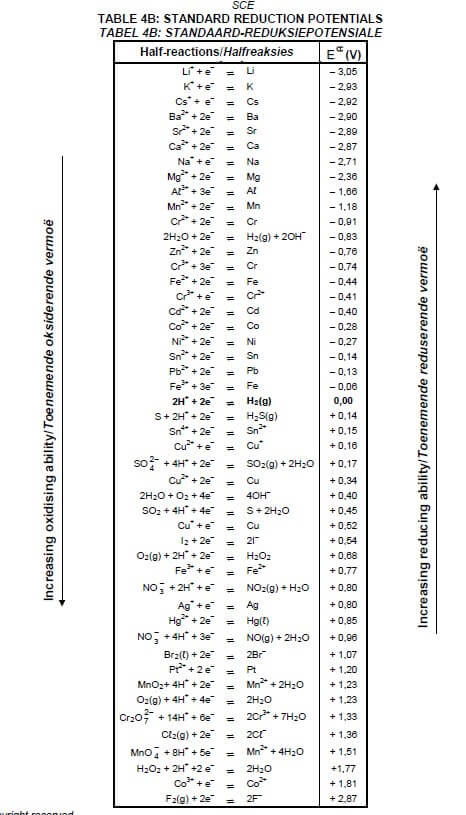PHYSICAL SCIENCES GRADE 12 PAPER 2 QUESTIONS - NSC PAST PAPERS AND MEMOS SEPTEMBER 2017
Share via Whatsapp Join our WhatsApp Group Join our Telegram GroupPHYSICAL SCIENCES
GRADE 12
PAPER 2
NSC PAST PAPERS AND MEMOS
SEPTEMBER 2017
INSTRUCTIONS AND INFORMATION
- Write your full NAME and SURNAME in the appropriate spaces on the ANSWER BOOK.
- This question paper consists of TEN questions. Answer ALL the questions in the ANSWER BOOK.
- Start EACH question on a NEW page in the ANSWER BOOK.
- Number your answers correctly according to the numbering system used in this question paper.
- Leave ONE line between two subquestions, for example between QUESTION 2.1 and QUESTION 2.2.
- You may use a non-programmable calculator.
- You may use appropriate mathematical instruments.
- You are advised to use the attached DATA SHEETS.
- Show ALL formulae and substitutions in ALL calculations.
- Round off your final numerical answers to a minimum of TWO decimal places.
- Give brief motivations, discussions et cetera where required.
- Write neatly and legibly.
QUESTIONS
QUESTION 1: MULTIPLE-CHOICE QUESTIONS
Four possible options are provided as answers to the following questions. Each question has only ONE correct answer. Write only the correct letter (A–D) next to the question number (1.1–1.10) in the ANSWER BOOK for example 1.11 E.
1.1 Which ONE of the following about hydrocarbons is TRUE?
Hydrocarbons always contain …
- single bonds only.
- carbon and hydrogen atoms only.
- carbon, hydrogen and oxygen atoms only.
- double or triple bonds between carbon atoms only. (2)
1.2 A group of organic compounds with the same general formula is called a …
- polymer
- macromolecule.
- functional group.
- homologous series. (2)
1.3 The flow diagram below shows the conversion of compounds with the general formula CnH2n to other compounds. 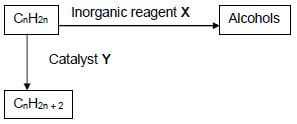
Which ONE of the following CORRECTLY gives the formula of catalyst Y and the formula of the inorganic reagent X? (2)
Formula of catalyst Y | Formula of inorganic reagent X | |
A | Pd | H2O |
B | Pd | Dilute KOH |
C | H2SO4 | H2O |
D | H2SO4 | Dilute KOH |
1.4 Which ONE of the following reactions DOES NOT form part of the production of sulphuric acid (H2SO4) in the contact process?
- S + O2 →SO2
- 2SO2 + O2 → 2SO3
- SO3 + H2O → H2SO4
- SO3 + H2SO4 → H2S2O7 (2)
1.5 Niric acid (HNO3) ionises according to the equation:
HNO3(ℓ) + H2O(ℓ) ⇌ NO-3 (aq) + H3O+(aq)
Which ONE of the following is a CORRECT conjugate acid-base pair?
- HNO3 and H2O
- NO-3 and H3O+
- HNO3 and NO-3
- NO-3 and H2O (2)
1.6 When a chemical reaction reaches equilibrium …
- concentrations of the reactants and products are equal.
- concentration of products is always higher than that of reactants.
- the rate of the forward reaction equals the rate of the reverse reaction.
- the rate of the forward reaction is higher than the rate of the reverse reaction. (2)
1.7 The reaction between nitrogen dioxide and carbon monoxide is represented by the equation below.
NO2(g) + CO(g) ⇌ NO(g) + CO2(g)
The potential energy diagram for the reaction is given below. 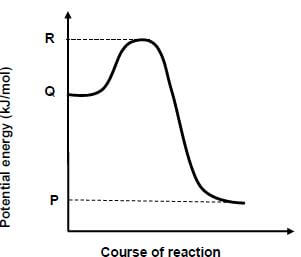
With reference to the energies represented by P, Q and R the activation energy for the reverse reaction is:
- R – P
- Q + R
- R – Q
- P – Q (2)
1.8 Sodium hydroxide pellets (NaOH) are added to water until the following equilibrium is established:
NaOH(s) + H2O (ℓ) ⇌ Na+(aq) + OH-(aq)
The pH of the solution is 8,5.
When a few drops of a concentrated solution of sodium chloride (NaCℓ) are added to the equilibrium mixture the pH of the equilibrium mixture will be …
- equal to 7.
- lower than 8,5.
- higher than 8,5.
- unchanged at 8,5. (2)
1.9 The following redox pairs are used in a galvanic cell.
Sn4+/ Sn2+ and Ag+/ Ag
Which substance is the STRONGEST reducing agent? Refer to the Table of Reduction Potentials.
- Sn4+
- Ag+
- Sn2+
- Ag (2)
1.10 The electrochemical cell below is used for the electrolysis of a concentrated solution of sodium chloride (NaCℓ). 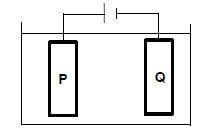
Consider the following statements regarding the cell:
- Sodium (Na) is formed at electrode Q
- The chloride ion is the oxidising agent.
- The solution is alkaline when the reaction is complete.
Which of the above statements is/are TRUE?
- I only
- II only
- III only
- I and III only (2) [20]
QUESTION 2 (Start on a new page.)
The letters A–F in the table below represent six organic compounds. (1) 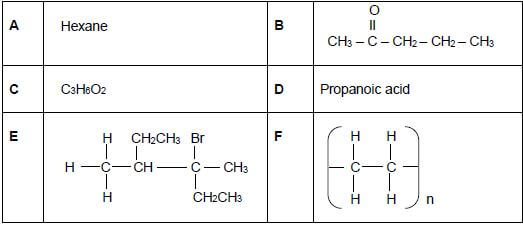
Use the information in the table to answer the QUESTIONS 2.1 to 2.5. 2.1 Write down the LETTER that represents a compound that is:
2.1.1 A ketone (1)
2.1.2 A large molecule composed of smaller monomer units covalently bonded to each other in a repeating pattern (1)
2.2 Write down the IUPAC name of:
2.2.1 Compound B (2)
2.2.2 Compound E (3)
2.3 Compound C is prepared by the reaction of methanol with a carboxylic acid in the presence of concentrated sulphuric acid.
Write down the:
2.3.1 Name of the homologous series to which compound C belongs (1)
2.3.2 STRUCTURAL FORMULA of the carboxylic acid used (2)
2.3.3 STRUCTURAL FORMULA of compound C (2)
2.4 Compound D is one of the STRUCTURAL ISOMERS of compound C.
2.4.1 Define the term structural isomer. (2)
2.4.2 Write down the IUPAC name of another STRUCTURAL ISOMER of compound C, other than compound D. (2)
2.5 Compound A undergoes a cracking process in which shorter chain hydrocarbons X and Y are produced according to the equation: 
2.5.1 Classify the cracking process as CATALYTIC or THERMAL. (1)
‘Shorter chain’ hydrocarbon X is a monomer of compound F shown in the table.
2.5.2 Write down the MOLECULAR FORMULA of compound Y. (1) [18]
QUESTION 3 (Start on a new page.)
The flow diagram below shows various organic reactions. 
3.1 Is propan-2-ol a PRIMARY, SECONDARY or TERTIARY alcohol? (1)
3.2 NAME the type of reaction represented by:
3.2.1 A (1)
3.2.2 B (1)
3.2.3 C (1)
3.3 Write down the STRUCTURAL FORMULA of the haloalkane. (2)
3.4 Use STRUCTURAL FORMULAE to write down a balanced equation for reaction C. (5)
3.5 Reaction B takes place in the presence of a strong base. Is the base used in reaction B DILUTE or CONCENTRATED? (1) [12]
QUESTION 4 (Start on a new page.)
4.1 Vapour pressure values for compounds E and F are shown in the table below. The data was obtained at the same temperature of 20 °C using equal volumes of the compounds E and F.
COMPOUND | VAPOUR PRESSURE (in kPa at 20 °C) | |
E | Ethanoic acid | 0,5 |
F | Propan-1-ol | 2 |
4.1.1 Define the term vapour pressure. (2)
4.1.2 Besides the two control variables underlined above, write down another control variable for this comparison. (1)
4.1.3 Give a reason why hydrogen bonds in compound E are stronger, than in compound F. (1)
4.2 Learners carried out an investigation into the factors that affect the boiling points of compounds A to D shown in the table below.
The results of the investigation are shown in the table below. 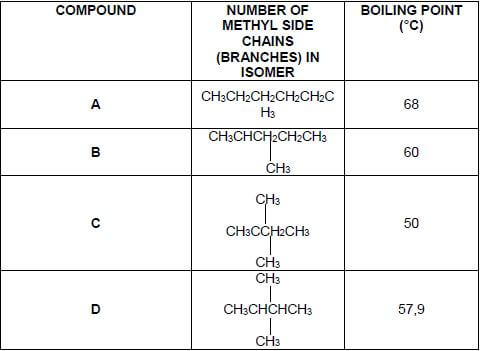
4.2.1 Explain the trend in the boiling points from A to C. (3) The boiling points of compounds C and D are compared.
4.2.2 Write down the independent variable for this comparison. (1)
Compound A required exactly 96 dm3 of oxygen at STP for complete combustion according to the reaction represented by the equation below.
2C6H14 + 19O2 12CO2 + 14H2O ∆H = - 4163 kJ/mol of C6H14
4.2.3 Calculate the net energy released by the reaction. (4) [12]
QUESTION 5 (Start on a new page.)
Learners investigate the factors that influence the rate of reaction.
In experiment 1: One mole of zinc granules reacts with EXCESS dilute hydrochloric acid at 25 °C in an open flask.
Zn (s) + 2HCℓ(aq) ZnCℓ2(s) + H2(g) ∆H < 0
5.1 What change can be made to each of the following in order to increase the rate of production of hydrogen gas?
5.1.1 Zinc granules (1)
5.1.2 Temperature (1)
5.2 A sketch graph of the change in mass of the contents of the flask versus time is shown below. 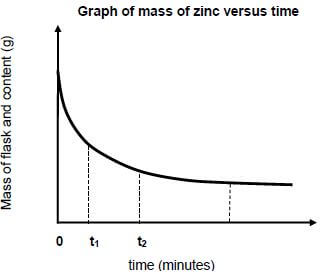
5.2.1 What does the horizontal part after t3 indicate about the reaction? (1)
5.2.2 At what time (t1, t2 or t3) is the reaction rate the HIGHEST?
Give a reason by referring to the graph. (2)
5.3 Two more experiments (experiments 2 and 3) are carried out by changing one condition in experiment 1.
In experiment 2 the zinc granules in experiment 1 are replaced with one mole of magnesium ribbon.
In experiment 3 zinc granules in experiment 1 are replaced with one mole of copper turnings.
5.3.1 Redraw the graph in QUESTION 5.2 and label it Zn. On the same set of axes, sketch a graph that would be obtained for experiment 2 and label it Mg. (2)
5.3.2 Refer to the relative strengths of oxidising agents from the table of reduction potentials to explain why copper will not react with hydrochloric acid. (2)
5.4 A fourth experiment (experiment 4) is carried out by changing one reaction condition in experiment 2.
Two energy distribution curves for the reaction in experiments 2 and 4 are shown in the graph below. 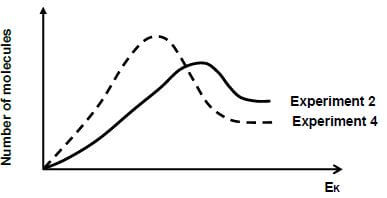
5.4.1 What change was made to the reaction conditions in experiment 2 to obtain the results of experiment 4? (1)
5.4.2 Use the collision theory to explain how the change mentioned in QUESTION 5.4.1 above affects the rate of the reaction. (4) [14]
QUESTION 6 (Start on a new page.)
The following reversible reaction takes place in a closed container:
3X2 (g) + 2A(s) ⇌ 2AX3 (g)
6.1 Define the term reversible reaction. (2)
6.2 The reaction reaches equilibrium at a temperature of 300 K.
How will EACH of the following changes affect the amount of X2?
Choose from INCREASES, DECREASES or REMAINS CONSTANT.
6.2.1 Removing AX3 as it forms. (1)
6.2.2 Decreasing pressure by increasing the volume. (1)
The graph below shows how the equilibrium constant Kc changes with temperature for the reaction: 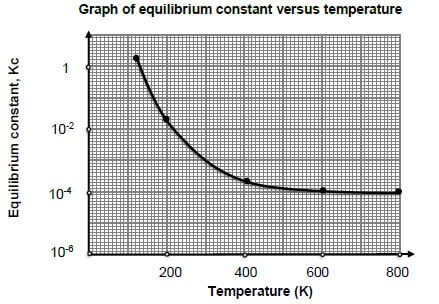
6.3 Refer to the graph to write down the value of Kc at 300 K. (1)
6.4 When 0,46 moles of X2 and excess A are initially sealed in a container the system reaches equilibrium at 300K.
The concentration of AX3 at equilibrium is found to be 0,1 mol.dm-3.
Calculate the volume of the container. (8)
6.5 What effect will an increase in temperature have on the amount of AX3 at equilibrium? ONLY write down INCREASES, DECREASES or REMAINS CONSTANT. Use Le Chatelier’s principle and information from the graph to explain the answer. (4) [17]
QUESTION 7 (Start on a new page.)
7.1 A salt reacts with water according to the balanced net (overall) equation:
CO32- (aq) + H2O(ℓ) ⇌ HCO-3 (aq) + OH (aq) Kb = 2,13 x 10 -4 at 25 °C
7.1.1 Write down a term for the reaction of a salt with water. (1)
7.1.2 Is the carbonate ion (CO32 ) a STRONG or WEAK base? Support the answer by referring to the given Kb value. (2)
7.1.3 Are the two substances (H2O and HCO3 ) acting as ACIDS or BASES in the reaction? Give a reason. (2)
7.2 In a titration exactly 40 cm3 of a strong diprotic acid (H2X) of unknown concentration is neutralised by a sodium hydroxide solution (NaOH) of concentration 0,1 mol.dm-3.
The reaction is represented by the balanced equation given below.
H2X(aq) + 2NaOH(aq) Na2X(aq) + 2H2O(ℓ)
Apparatus X shown below is used to measure the initial and final volume of sodium hydroxide used during the titration. 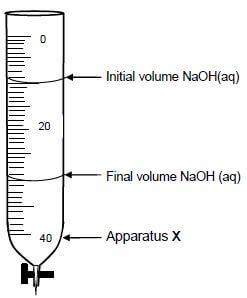
7.2.1 Write down the NAME of apparatus X. (1)
7.2.2 Write down the volume of sodium hydroxide used in the titration in cm3. (1)
7.2.3 Calculate the number of moles of sodium hydroxide that reacted during the titration. (3)
7.2.4 Calculate the pH of the diprotic acid H2X, before it was used in the titration. (5)
7.2.5 Is the solution at the endpoint ACIDIC, ALKALINE or NEUTRAL? Give a reason for your answer. (2) [17]
QUESTION 8 (Start on a new page.)
A galvanic cell is set up based on the reaction represented by the equation below. The reaction takes place under standard conditions.
3Ag+ + Ti ⇌ 3Ag + Ti3+
Silver nitrate (AgNO3) and Titanium nitrate (Ti(NO3)3) solutions are used as electrolytes. 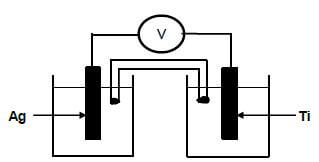
8.1 Define the term electrolyte. (2)
8.2 To which terminal of the voltmeter is the Ag electrode connected? Write down only POSITIVE or NEGATIVE. Give a reason. (2)
8.3 For this galvanic cell, write down the:
8.3.1 Initial concentration of the electrolytes (1)
8.3.2 Cell notation (3)
8.4 The initial reading on the voltmeter is 2,43 volts.
Calculate the standard reduction potential of the Ti electrode. (4)
8.5 A new cell is set up under standard conditions by replacing the half-cell Ag+/Ag with Mg2+/Mg half-cell. Write down a balanced equation for the overall (net) cell reaction in the new cell. (3) [15]
QUESTION 9 (Start on a new page)
The electrolytic cell, P, shown below is used to purify an IMPURE copper sample for use in electrical wires. Copper (II) chloride solution, CuCℓ2, is used as the electrolyte. Electrode B contains 95,7% Cu by mass. 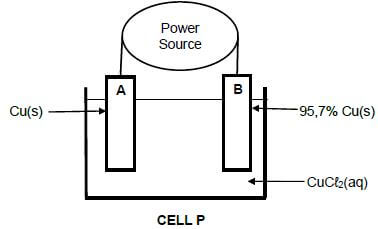
9.1 Is electrode A, the POSITIVE or NEGATIVE electrode? (1)
9.2 Give a reason for the need to refine copper before using it in electrical wires. (1)
9.3 Will the mass of electrode B INCREASE or DECREASE when the cell is in operation? Write down a relevant half reaction to support the answer. (3)
9.4 After ALL the copper was purified, it was found that 2 moles of electrons were transferred from anode to cathode. Calculate the mass of the IMPURE copper sample. (5) [10]
QUESTION 10 (Start on a new page.)
The flow diagram below shows the processes involved in the industrial production of the fertiliser Y. 
Compound X is a product of the Haber process.
10.1 Write down the:
10.1.1 Name of compound X (1)
10.1.2 Name of the process B represented by Step 1 to 3 (1)
10.1.3 Formula of Gas A (1)
10.1.4 Formula of ACID Q and the other product in Step 3 (2)
10.1.5 Balanced equation for the reaction of compound X and ACID Q (3)
10.2 To produce an NPK fertiliser, 39,6 kg of pure ammonium sulphate, (NH4)2SO4, is mixed with some phosphates and potassium salts. A bag of fertiliser marked as shown below was obtained. 
10.2.1 What does the number 36 on the bag indicate? (1)
10.2.2 Write down ONE negative impact of eutrophication on the environment. (1)
10.2.3 Calculate the mass (m) of the contents of the bag in kg.
(ASSUME THAT THE ONLY SOURCE OF NITROGEN IS THE AMMONIUM SULPHATE.) (5) [15]
TOTAL: 150
NATIONAL SENIOR CERTIFICATE
DATA FOR PHYSICAL SCIENCES GRADE 12
PAPER 2 (CHEMISTRY)
TABLE 1: PHYSICAL CONSTANTS
NAME | SYMBOL | VALUE |
Standard pressure | pθ | 1,013 x 105 Pa |
Molar gas volume at STP | Vm | 22,4 dm3∙mol-1 |
Standard temperature | Tθ | 273 K |
Charge on electron | e | -1,6 x 10-19 C |
Avogadro's constant | NA | 6,02 x 1023 mol-1 |
TABLE 2: FORMULAE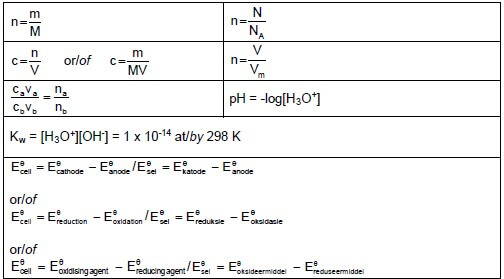
TABLE 3: THE PERIODIC TABLE OF ELEMENTS 
TABLE 4A: STANDARD REDUCTION POTENTIALS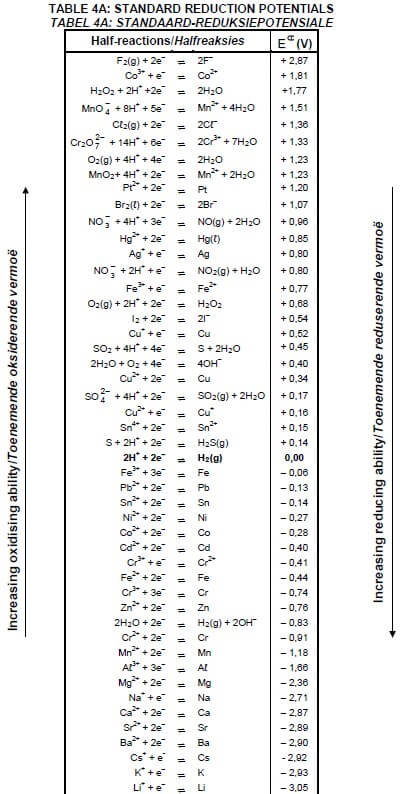
TABLE 4B: STANDARD REDUCTION POTENTIALS